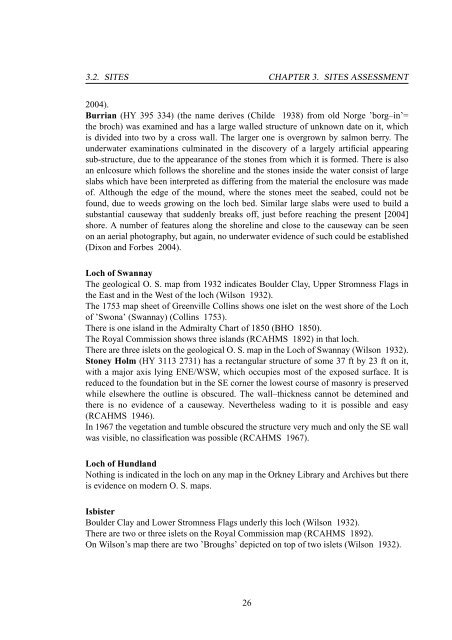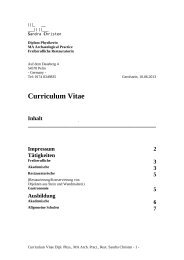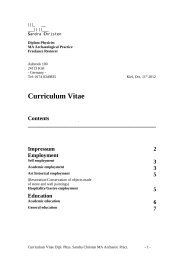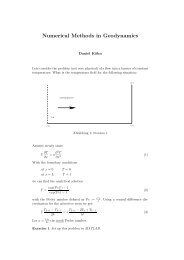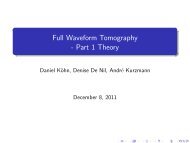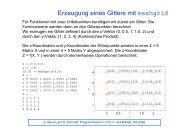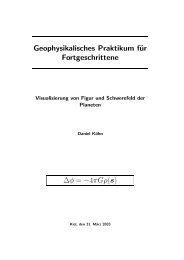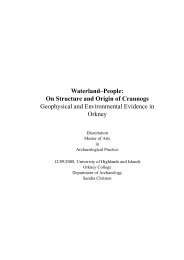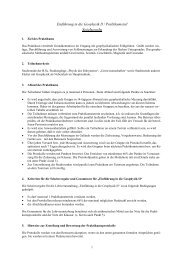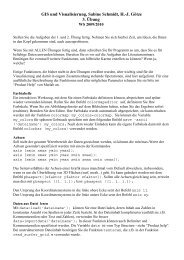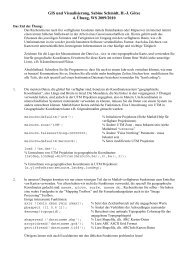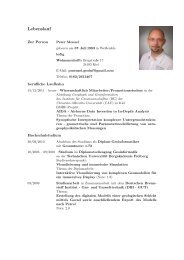Waterland–People: On Structure and Origin of Crannogs ...
Waterland–People: On Structure and Origin of Crannogs ...
Waterland–People: On Structure and Origin of Crannogs ...
Create successful ePaper yourself
Turn your PDF publications into a flip-book with our unique Google optimized e-Paper software.
3.2. SITES CHAPTER 3. SITES ASSESSMENT<br />
2004).<br />
Burrian (HY 395 334) (the name derives (Childe 1938) from old Norge ’borg–in’=<br />
the broch) was examined <strong>and</strong> has a large walled structure <strong>of</strong> unknown date on it, which<br />
is divided into two by a cross wall. The larger one is overgrown by salmon berry. The<br />
underwater examinations culminated in the discovery <strong>of</strong> a largely artificial appearing<br />
sub-structure, due to the appearance <strong>of</strong> the stones from which it is formed. There is also<br />
an enlcosure which follows the shoreline <strong>and</strong> the stones inside the water consist <strong>of</strong> large<br />
slabs which have been interpreted as differing from the material the enclosure was made<br />
<strong>of</strong>. Although the edge <strong>of</strong> the mound, where the stones meet the seabed, could not be<br />
found, due to weeds growing on the loch bed. Similar large slabs were used to build a<br />
substantial causeway that suddenly breaks <strong>of</strong>f, just before reaching the present [2004]<br />
shore. A number <strong>of</strong> features along the shoreline <strong>and</strong> close to the causeway can be seen<br />
on an aerial photography, but again, no underwater evidence <strong>of</strong> such could be established<br />
(Dixon <strong>and</strong> Forbes 2004).<br />
Loch <strong>of</strong> Swannay<br />
The geological O. S. map from 1932 indicates Boulder Clay, Upper Stromness Flags in<br />
the East <strong>and</strong> in the West <strong>of</strong> the loch (Wilson 1932).<br />
The 1753 map sheet <strong>of</strong> Greenville Collins shows one islet on the west shore <strong>of</strong> the Loch<br />
<strong>of</strong> ’Swona’ (Swannay) (Collins 1753).<br />
There is one isl<strong>and</strong> in the Admiralty Chart <strong>of</strong> 1850 (BHO 1850).<br />
The Royal Commission shows three isl<strong>and</strong>s (RCAHMS 1892) in that loch.<br />
There are three islets on the geological O. S. map in the Loch <strong>of</strong> Swannay (Wilson 1932).<br />
Stoney Holm (HY 3113 2731) has a rectangular structure <strong>of</strong> some 37 ft by 23 ft on it,<br />
with a major axis lying ENE/WSW, which occupies most <strong>of</strong> the exposed surface. It is<br />
reduced to the foundation but in the SE corner the lowest course <strong>of</strong> masonry is preserved<br />
while elsewhere the outline is obscured. The wall–thickness cannot be detemined <strong>and</strong><br />
there is no evidence <strong>of</strong> a causeway. Nevertheless wading to it is possible <strong>and</strong> easy<br />
(RCAHMS 1946).<br />
In 1967 the vegetation <strong>and</strong> tumble obscured the structure very much <strong>and</strong> only the SE wall<br />
was visible, no classification was possible (RCAHMS 1967).<br />
Loch <strong>of</strong> Hundl<strong>and</strong><br />
Nothing is indicated in the loch on any map in the Orkney Library <strong>and</strong> Archives but there<br />
is evidence on modern O. S. maps.<br />
Isbister<br />
Boulder Clay <strong>and</strong> Lower Stromness Flags underly this loch (Wilson 1932).<br />
There are two or three islets on the Royal Commission map (RCAHMS 1892).<br />
<strong>On</strong> Wilson’s map there are two ’Broughs’ depicted on top <strong>of</strong> two islets (Wilson 1932).<br />
26


